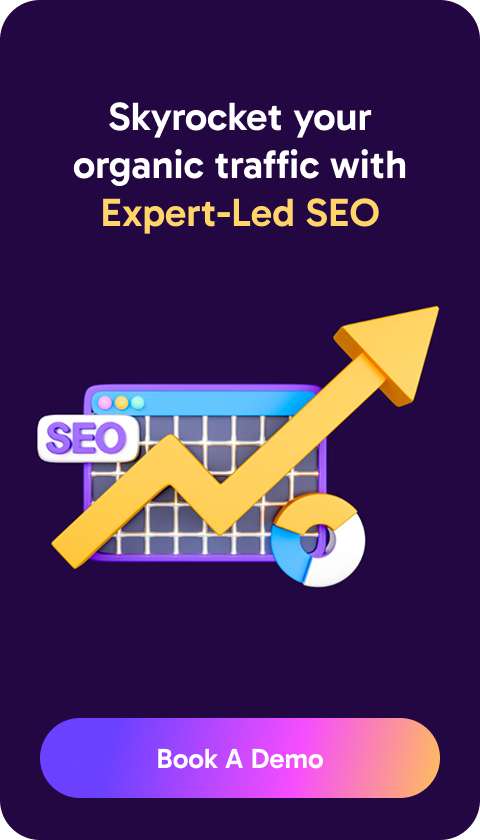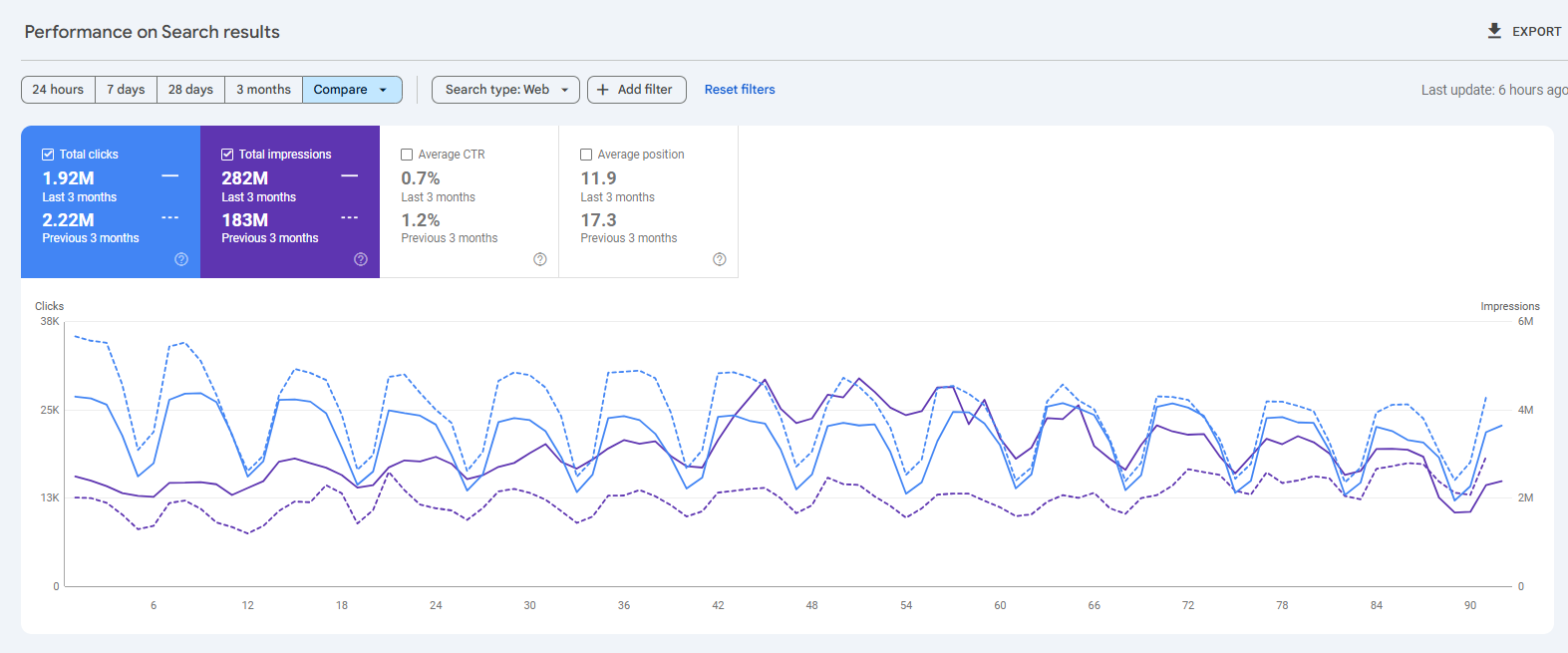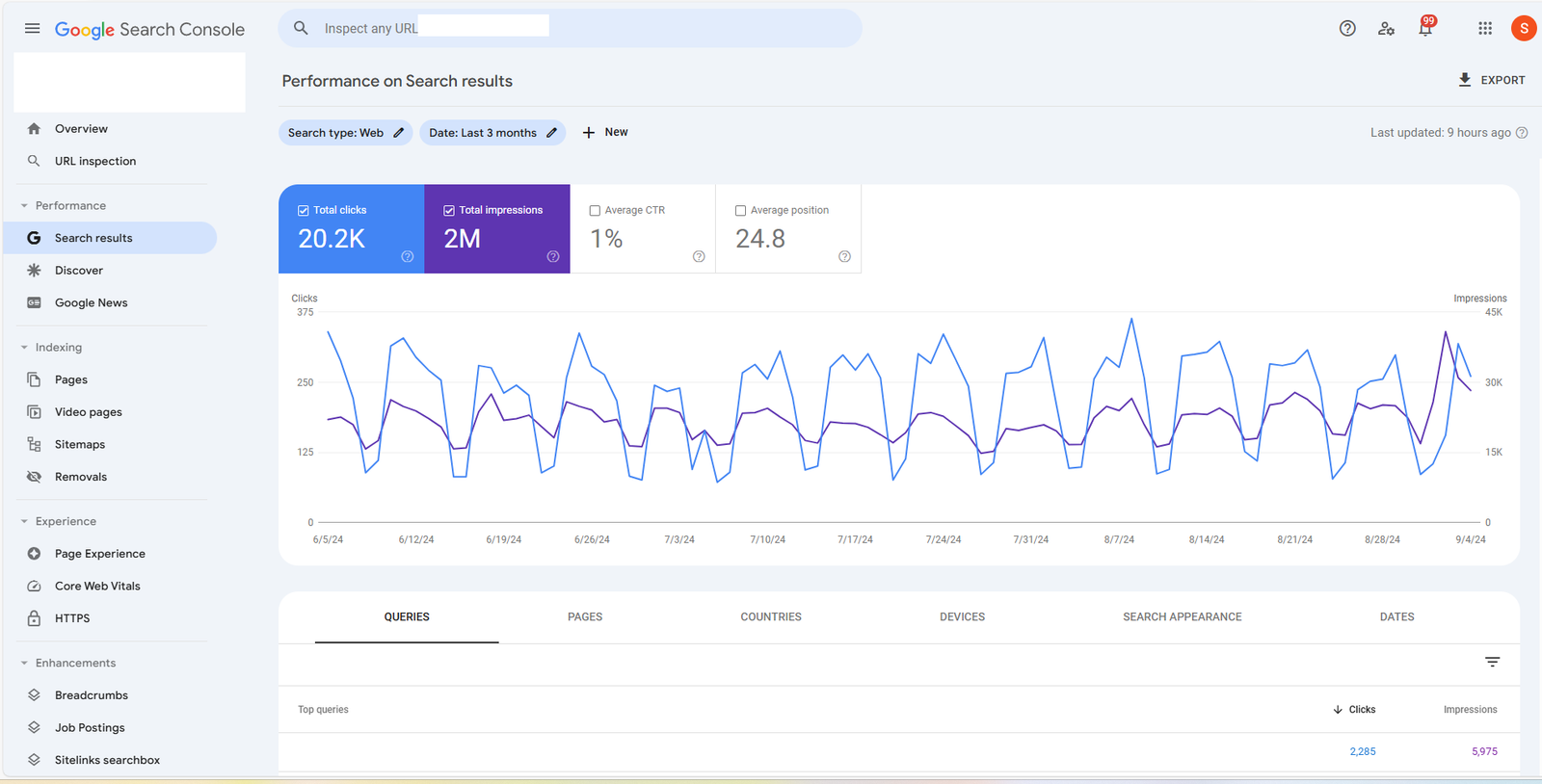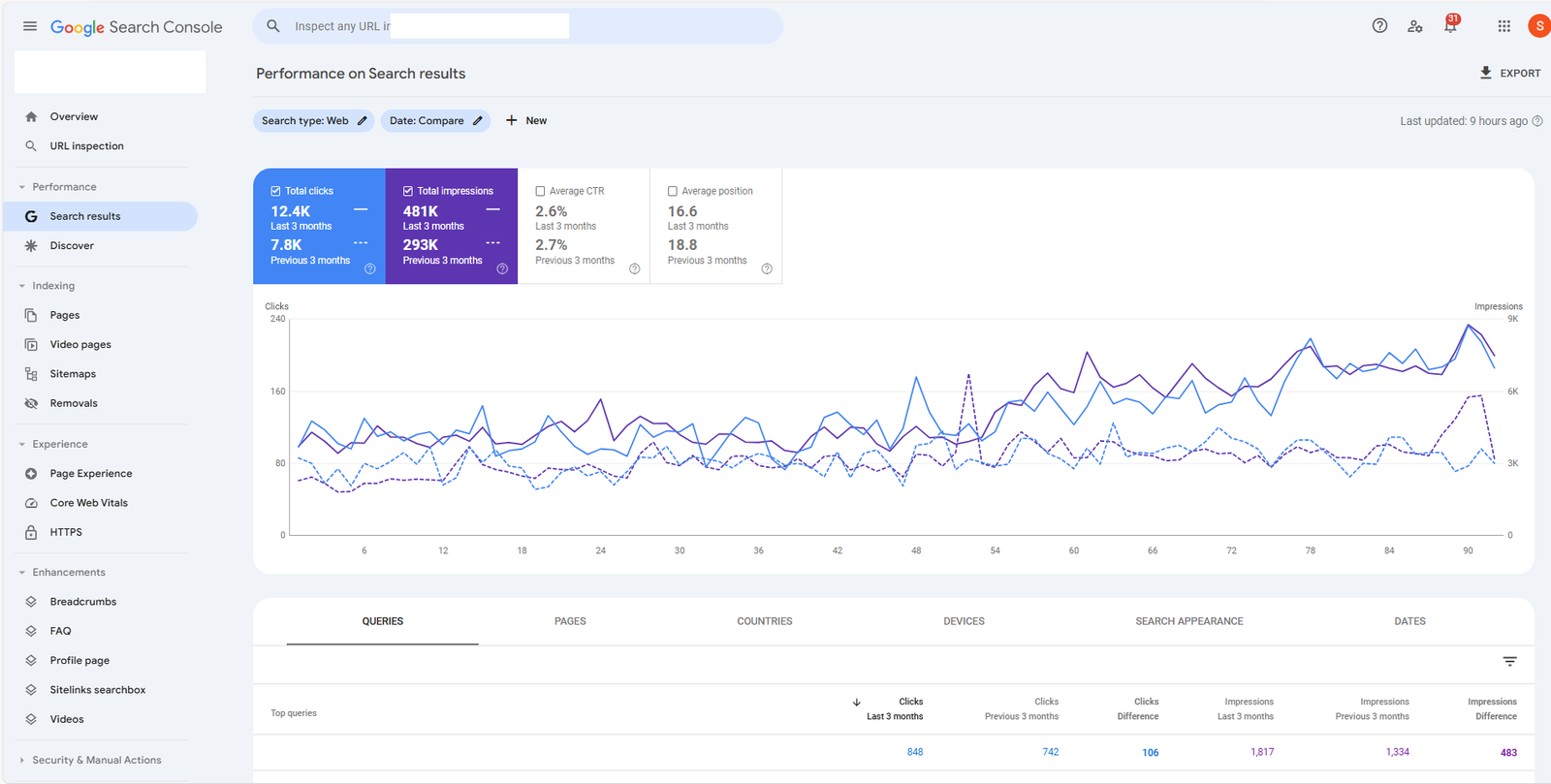Programmatic SEO Tools
- Programmatic SEO tools help scale content for health, e-commerce, and product pages effortlessly.
- Top-rated programmatic SEO tools 2025 offer automation features, analytics, and CMS integration for maximum efficiency.
- Use SEO software and tools to automate content creation and maintain brand voice consistency across platforms.
- Choose the best programmatic SEO tools customizable analytics 2025 to track, optimize, and boost client performance.
In this post, we are going to look at Best Programmatic SEO Tools which I have personally tested in 2025. While heading marketing for other SaaS companies, I have spent a lot of time evaluating programmatic SEO tools.
What is Programmatic SEO and How Does It Work?
Looking to scale your content strategy without compromising on SEO quality? That’s where programmatic SEO tools come into play. Here’s what you need to know about how this powerful approach works in 2025.
1. Programmatic SEO Explained: Automate at Scale
Programmatic SEO is the process of using data-driven templates, automation, and tools to create SEO-optimized content pages at scale. Rather than handcrafting each page, businesses rely on structured data (like product specs, location info, or blog metadata) and combine that with programmatic SEO software to generate hundreds or thousands of pages.
These pages often target long-tail or highly specific keywords—perfect for e-commerce, marketplaces, directories, and health blogs. With the right programmatic SEO tools, you can automate everything from page creation to meta descriptions, ensuring each page is unique, crawlable, and optimized for search engines.
2. Why Programmatic SEO Is Crucial in 2025
The SEO landscape in 2025 demands efficiency, personalization, and scalability. That’s why more SEO teams and businesses are turning to the best programmatic SEO tools to dominate organic search. Here’s why it matters:
- Search competition is tougher, requiring rapid content production
- Google values structured, semantically relevant pages at scale
- Programmatic content meets the demand for niche, long-tail queries
- Automation helps teams avoid repetitive work while boosting visibility
Programmatic SEO software now includes intelligent automation features, CMS integration, and customizable analytics—giving SEO professionals the firepower they need to stay ahead.
3. Real-World Use Cases for Programmatic SEO Tools
Wondering how these tools are applied in practice? Below are key scenarios where top-rated programmatic SEO tools 2025 shine:
- E-Commerce Platforms
Want to know what are the top programmatic SEO tools for optimizing product pages? These tools auto-generate landing pages for every product variant—like “Red Leather Jacket for Women” or “Size 12 Running Shoes in Black.” This ensures fast publishing and consistent optimization. - Health & Wellness Blogs
How can I leverage programmatic SEO tools to optimize my existing health articles? Easy—pair structured data (e.g., benefits, conditions, ingredients) with dynamic templates to generate expert-style posts like “Top Supplements for Joint Pain” or “5 Herbal Remedies for Anxiety.” - Service Aggregators & Local SEO
For platforms targeting multiple locations, programmatic content works wonders. Tools generate localized pages like “Top-rated Plumbers in Bangalore” or “Best Vegan Restaurants in Chennai” using automation and city-specific data.
Perfect! Here’s the second H2 section written in listicle format, aligned with your structure and optimized for the required keywords:
Key Features to Look for in Programmatic SEO Tools
With so many programmatic SEO tools available in 2025, choosing the right one can be overwhelming. To make the best decision for your business or agency, you need to know what are the key features I should look for in programmatic SEO tools to boost client performance. Below are the essential features that define top-performing tools in the market.
1. Scalability: Handle Thousands of Pages with Ease
One of the most important key features of programmatic SEO tools is scalability. Whether you’re running a small affiliate site or an enterprise e-commerce platform, the tool should be able to manage the creation, optimization, and deployment of thousands of pages with minimal effort.
Look for tools that:
- Allow bulk content and metadata generation
- Support large datasets (products, services, locations)
- Manage page templates at scale without slowing down
If you’re targeting dozens of niches or long-tail variations, scalability ensures your content engine never hits a bottleneck.
2. Customization: Flexible Templates & Structured Data Use
Customization is at the core of successful programmatic SEO tools. Your content should be unique, even if it’s generated from a template. This includes:
- Dynamic placeholder fields for inserting data (like {product_name}, {city}, {feature})
- The ability to build custom templates for various content types
- Field-level controls for SEO metadata, internal linking, and heading structure
This is especially useful for e-commerce, where product attributes vary greatly. The key features of programmatic SEO tools should give you full control over the structure and voice of your output.
3. Seamless Integration with CMS Platforms
CMS compatibility is non-negotiable. Programmatic SEO tools for CMS integration like WordPress, Webflow, and Shopify allow you to auto-publish content directly without manual uploads. They support:
- Low-code embedding into page templates
- API-based integrations for real-time publishing
- Compatibility with popular CMS plugins and SEO extensions
Looking for the best tools for programmatic SEO e-commerce? Go for platforms that integrate smoothly with your tech stack and push updates to live pages automatically.
4. Automation: Save Time, Reduce Errors
Modern programmatic SEO tools go beyond just content generation. They automate technical SEO tasks like:
- Generating sitemaps and updating robots.txt
- Auto-linking internal pages based on topic or category
- Automating image insertion, schema markup, and meta description tags
This reduces human error and boosts your productivity—crucial for agencies managing multiple clients.
5. Built-In Analytics for Performance Tracking
Another key differentiator is whether the tool provides actionable data. The best programmatic SEO tools customizable analytics 2025 include dashboards to:
- Monitor organic traffic and keyword rankings
- Track content performance across templates
- Analyze bounce rate, conversion, and page speed at scale
With customizable reports, you can show clear ROI to clients while continuously improving your programmatic content strategy.
6. Low-Code Capabilities for Flexibility
Not every SEO is a developer—and you shouldn’t have to be. Leading tools offer low-code or no-code environments to:
- Build templates visually
- Import/export datasets easily
- Configure publishing rules without writing scripts
This is a huge win for marketers, content creators, and SEOs who want control without the need for full-stack development knowledge.
Pro Tip: If you’re focused on client results, prioritizing these key features of programmatic SEO tools will give your team a scalable edge. From CMS integration to automation and analytics, the right stack will transform your content workflow.
Comparison Table: Programmatic seo tools
| Tool Name | Key Features | Ease of Use | AI Capabilities | Pricing (Starting) | Best For |
| ChatGPT | Scalable AI writer with structured prompts, integrations, and bulk content generation | ⭐⭐⭐⭐☆ | Supports pSEO, multiple formats, APIs, high-volume content | $20/month | Programmatic SEO in eCommerce, health, SaaS, local SEO |
| Jasper | SEO-optimized copy with 50+ templates and brand tone control | ⭐⭐⭐⭐ | Uses GPT-4o, Claude 3.5, Gemini for varied outputs | $39/month | Large-scale, brand-consistent programmatic SEO campaigns |
| Frase | Automates briefs, outlines, keyword research, and SEO content optimization | ⭐⭐⭐ | AI-driven SERP analysis and content workflows | $45/month | Agencies and teams needing full-funnel, data-backed programmatic SEO |
| Ahrefs | Advanced keyword research, SERP insights, backlink audits, and rank tracking | ⭐⭐⭐ | Data-driven keyword and backlink analysis | $129/month | SEO professionals and agencies scaling content & product pages with competitive insights |
| Semrush | Keyword clustering, competitor gap analysis, SERP insights, and SEO audits | ⭐⭐⭐ | Data-driven keyword clustering and content planning | $117/month | Marketers needing an all-in-one SEO platform for scalable programmatic SEO campaigns |
| LowFruits | Identifies low-competition, long-tail keyword opportunities by analyzing SERP weaknesses; ideal for niche and programmatic SEO | ⭐⭐⭐⭐ | Focused SERP gap detection for targeted keyword discovery | $21/month | Beginners and solo marketers seeking quick, easy-to-rank keyword ideas without full-suite SEO complexity |
| AnswerThePublic | Pulls keyword suggestions from Google, Bing, and YouTube, displaying them in visual maps; great for FAQs, topical clusters, and question-based keyword planning | ⭐⭐⭐⭐ | Visual keyword mapping and clustering for idea generation | $5/month | Marketers and content creators needing quick keyword ideation for FAQs, comparisons, and large-scale content mapping |
| ScrapingBee – Scalable Web Scraping API for Structured Data | Scalable web scraping with proxy rotation, JavaScript rendering, and anti-bot bypass | ⭐⭐☆☆☆ | No built-in AI, but integrates with AI analytics workflows | $49/month | Developers and marketers needing large-scale structured data extraction |
| Zapier | No-code automation connecting 5,000+ apps for SEO workflows | ⭐⭐⭐⭐☆ | Automates data sync, triggers AI content, streamlines SEO tasks | Free plan, Pro at $19.99/month | SEO teams needing code-free workflow automation |
| Bardeen | No-code browser automation with AI-powered scraping and CMS integration | ⭐⭐⭐⭐☆ | AI-driven scraping, workflow automation, and content filling | $129/month | Automating content creation and data scraping for programmatic SEO |
| Whalesync | Real-time two-way data sync between Airtable, Sheets, Webflow, Shopify | ⭐⭐⭐⭐⭐ | No-code automation, smart field mapping | $5/month | Streamlining programmatic SEO content publishing |
| Airtable | Customizable database with CMS integration and automation support | ⭐⭐⭐⭐☆ | Supports AI-driven content workflows via integrations | Free | Managing structured SEO data for programmatic SEO and e-commerce sites |
| Placid | Automates branded image creation from Airtable using custom templates | ⭐⭐⭐⭐☆ | Limited AI for dynamic text and image generation | $19/month | Scaling Open Graph and social media visuals for SEO pages |
| Canva | Automates bulk visual creation with templates, API, and datasets | ⭐⭐⭐⭐⭐ | Basic AI design suggestions and resizing automation | Free | Scalable, branded visuals for SEO-driven content pages |
| Figma | Builds reusable visual components for scalable SEO templates and assets | ⭐⭐⭐⭐ | Limited AI; supports automation via plugins and integrations | Free | Collaborative SEO-focused template design and visual scaling |
| Tailgraph | Converts data into charts, infographics, and visual reports for SEO pages | ⭐⭐⭐ | No native AI; supports automation via Google Sheets formulas | Free | Data-driven visuals for programmatic SEO and content credibility |
| Plausible | Privacy-focused, cookie-free SEO analytics with Google Search Console integration | ⭐⭐⭐⭐ | No AI features; focuses on lightweight analytics and real-time metrics | $9/month | Small sites needing privacy-first, lightweight SEO performance tracking |
| Matomo | Self-hosted analytics with deep customization and full data ownership | ⭐⭐⭐ | No AI features; focuses on detailed SEO performance analytics | Free self-hosted; Cloud hosting from approx $20/month | SEO pros needing privacy, granular tracking, and scalable analytics |
| GA4 (Google Analytics 4) | Event-driven tracking, custom conversions, multi-device analysis | ⭐⭐ | No AI; advanced analytics with event-based user data tracking | Free; GA4 360 enterprise custom pricing | High-volume SEO campaigns needing detailed user and conversion tracking |
| Google Search Console | Query-level SEO data, clicks, impressions, rankings | ⭐⭐⭐⭐ | No AI; provides direct SEO insights | Free | Monitoring organic visibility and indexing for SEO pages |
| Screaming Frog | Website crawler for broken links, metadata, SEO audits | ⭐⭐⭐ | No AI; technical SEO crawler | Free (up to 500 URLs) | Auditing technical SEO for large programmatic sites |
| Webflow | Visual site builder with CMS, SEO settings, API integrations | ⭐⭐ | No AI; low-code site building | Free Starter Plan | Scalable programmatic SEO with CMS & design control |
| WordPress | Highly customizable CMS with plugin ecosystem and API integrations | ⭐⭐ | No native AI; supports SEO automation via plugins | Free core; hosting & plugins vary (e.g., $59/year Elementor Pro) | Power users needing full control and complex SEO setups |
Content Table – Programmatic SEO Tools Breakdown
| Name | Category | USD/month (Starting) | Features | AI Tools |
| ChatGPT | 💵 Paid | $20 | 🏆 Scalable content, 🤖 AI writer, ✍️ Bulk generation, 🔗 Integrations | Yes |
| Jasper | 💵 Paid | $39 | 🏆 SEO templates, 🤖 GPT-4o & Claude, ✍️ Brand tone control | Yes |
| Frase | 💵 Paid | $45 | 🏆 Keyword research, 🤖 AI SERP analysis, ✍️ Content optimization | Yes |
| Ahrefs | 💵 Paid | $129 | 🏆 Keyword & backlink research, 🔍 Rank tracking | No |
| Semrush | 💵 Paid | $117 | 🏆 Keyword clustering, 🔍 Competitor analysis, SEO audits | No |
| LowFruits | 💵 Paid | $21 | 🏆 SERP gap analysis, 🔍 Keyword discovery | No |
| AnswerThePublic | 💵 Paid | $5 | 🏆 Visual keyword mapping, 🔍 Clustering | No |
| ScrapingBee | 💵 Paid | $49 | 🏆 Web scraping, 🔍 Proxy rotation, JavaScript rendering | No |
| Zapier | ⚙️ Free & 💵 Paid | Free / $19.99 Pro | 🏆 Automation, 🔗 5,000+ app integrations, 🤖 AI content triggers | Yes |
| Bardeen | 💵 Paid | $129 | 🏆 Browser automation, 🤖 AI scraping, CMS filling | Yes |
| Whalesync | 💵 Paid | $5 | 🏆 Two-way data sync, 🔗 Airtable & CMS integration | No |
| Airtable | 🗃️ Free | Free | 🏆 Custom databases, ⚙️ CMS integration, 🤖 AI via integrations | Yes |
| Placid | 💵 Paid | $19 | 🏆 Automates branded images, ✍️ Dynamic text/images | Limited |
| Canva | 🎨 Free | Free | 🏆 Bulk visuals, API, 🤖 Basic AI design suggestions | Yes (Basic) |
| Figma | 🎨 Free | Free | 🏆 Reusable visual components, ⚙️ Plugin automation | Limited |
| Tailgraph | 📊 Free | Free | 🏆 Data to charts, 🔗 Google Sheets automation | No |
| Plausible | 💵 Paid | $9 | 🏆 Privacy-focused analytics, 🔍 Google Search Console integration | No |
| Matomo | 📈 Free & 💵 Paid | Free / $20 Cloud | 🏆 Self-hosted analytics, 🔍 Deep customization | No |
| GA4 | 📈 Free | Free | 🏆 Event-driven tracking, 🔍 Multi-device analysis | No |
| Google Search Console | 📈 Free | Free | 🏆 Query-level SEO data, 🔍 Rankings, clicks | No |
| Screaming Frog | 🕷️ Free & 💵 Paid | Free (500 URLs) | 🏆 Website crawler, 🔍 SEO audits, broken link checks | No |
| Webflow | 🌐 Free & 💵 Paid | Free Starter | 🏆 Visual site builder, CMS, API integration | No |
| WordPress | 🌐 Free | Free core | 🏆 Customizable CMS, plugins, API integrations | No |
Top Content Generation Tools for Programmatic SEO
Creating high-quality content at scale is the foundation of any successful programmatic SEO strategy. In this section, we’ll explore the top tools for automating content creation for programmatic SEO—tools that help generate optimized articles, product pages, and landing copy, all while maintaining your unique brand voice.
These tools aren’t just about saving time—they’re about producing consistent, data-driven programmatic content that performs.
1. ChatGPT – Scalable AI Writer for Programmatic SEO Content
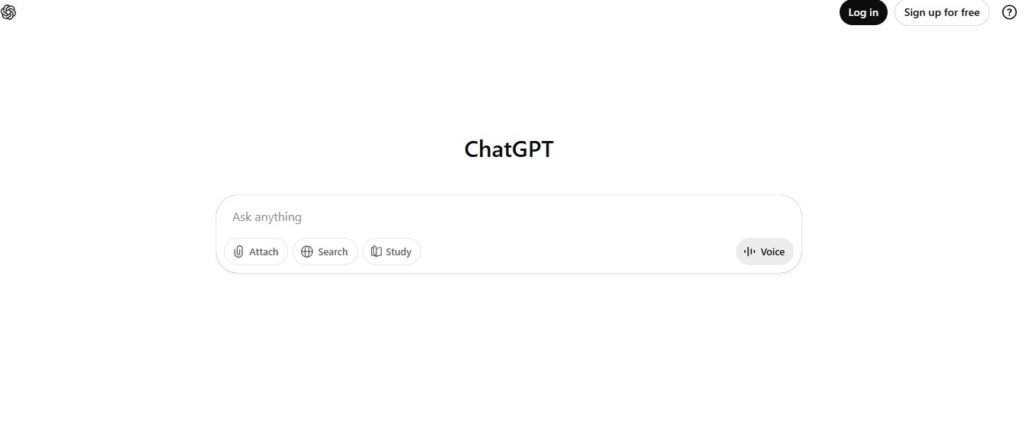
Features:
ChatGPT is a highly scalable AI-powered writer that supports structured prompting, content generation at scale, and integrations with tools like Google Sheets and Airtable. It’s ideal for programmatic content in niches like eCommerce, health, SaaS, and local SEO.
| Pros | Cons |
| Great for bulk content creation and ideation | Relies heavily on prompt quality |
| Handles varied formats (FAQs, product pages, etc.) | May produce hallucinated or inaccurate facts |
| Integrates with Sheets, Airtable, APIs | Requires manual review for compliance and tone |
| Affordable compared to most AI tools | Risk of generic or repetitive content |
Pricing:
- Free Tier (GPT-3.5 access only)
- Plus Plan – $20/month (GPT-4 access)
- Team Plan – $30/month per user
- Enterprise – Custom pricing
My Choice: Team Plan — It balances affordability and performance. With GPT-4 access and better usage limits, it supports high-volume pSEO projects without bottlenecks.
My Opinion:
ChatGPT is the most versatile tool in my programmatic SEO software stack. While it needs editing, the speed and scale it offers are unmatched. I use it across eCommerce, health, and SaaS sites to create everything from blog outlines to service pages—making it one of the best programmatic SEO tools of 2025.
2. Jasper – SEO-Focused AI Copywriter for Programmatic Content at Scale
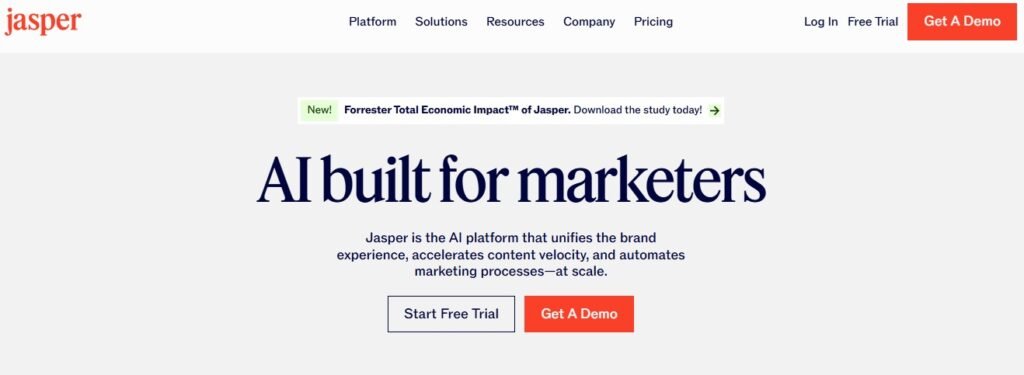
Features:
Jasper is an advanced AI copywriting platform designed for programmatic SEO content. It uses GPT-4o, Claude 3.5, and Gemini to produce SEO-optimized content for landing pages, blog posts, and eCommerce descriptions with brand consistency and speed.
| Pros | Cons |
| 50+ SEO-optimized templates for diverse content | High-quality features only in premium plans |
| Maintains consistent brand tone across large projects | No free version available |
| Supports multiple AI models (Claude, GPT, Gemini) | Repetitive outputs without strong prompts |
| Integrates with Google Sheets for automated workflows | Expensive for small teams or solo users |
Pricing:
- Creator – $39/month per seat
- Pro – $59/month per seat
- Business – Custom pricing
My Choice: Pro Plan. It unlocks advanced collaboration, content analytics, and ensures smooth scaling for large SEO campaigns across various industries.
My Opinion:
Among the top-rated programmatic SEO tools for 2025, Jasper stands out for speed and consistency. I use it heavily when optimizing eCommerce product pages and programmatic blog templates. It’s not cheap, but its automation features, CMS integration, and brand voice control make it worth it for serious SEO teams.
3. Frase – All-in-One AI Platform for Briefs, Outlines, and SEO Copy
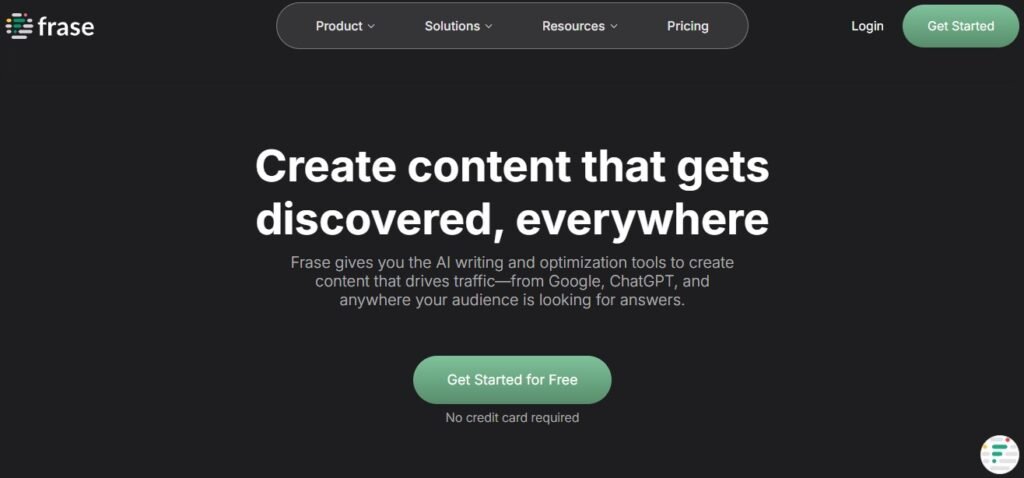
Features:
Frase automates the entire content lifecycle—keyword research, SERP analysis, brief generation, SEO outline creation, and content optimization. It’s a top-tier programmatic SEO tool ideal for scalable workflows, making it one of the best tools for automating content creation for programmatic SEO in 2025.
| Pros | Cons |
| Automates content briefs and keyword research | Higher price point for solo users |
| Excellent for SEO-driven outlines and stat inclusion | Steep learning curve for new users |
| Enables full-funnel workflows for content teams | Requires manual export for CMS integration |
Pricing:
- Starter Plan – $45/month (basic features)
- Professional Plan – $115/month (advanced content workflows)
- Enterprise Plan – Custom – For marketing teams needing to power complex content workflows.
- My Choice: Professional Plan. It supports our content automation needs end-to-end, and the SEO analytics justify the cost when scaling programmatic content for clients.
My Opinion:
Frase is one of the best programmatic SEO tools customizable for analytics in 2025. I find it particularly useful for health blogs and e-commerce projects that require consistent, structured content output. Its ability to align briefs with SERP data gives us a real edge in SEO performance.
Why These Tools Matter for Programmatic SEO
The best programmatic SEO tools for content generation 2025 don’t just create text—they craft content that ranks, converts, and scales. Whether you’re building a health knowledge base or optimizing an ecommerce product catalog, tools like ChatGPT, Jasper, and Frase give you full control over tone, structure, and quality.
When selecting tools for automating content creation for programmatic SEO, prioritize those that integrate well with your existing workflows and allow custom prompt engineering or templating.
Best Keyword Research Tools to Power Programmatic SEO
No programmatic content strategy can succeed without the right keywords. Whether you’re generating 50 pages or 5,000, your performance hinges on accurate keyword targeting. That’s why you need the right SEO software and tools to uncover high-volume, low-competition phrases that fuel your automation pipeline.
Below are the best keyword research tools to include in your SEO chiefs powerful SEO toolkit.
1. Ahrefs – Advanced SEO Software for Competitive Keyword Data
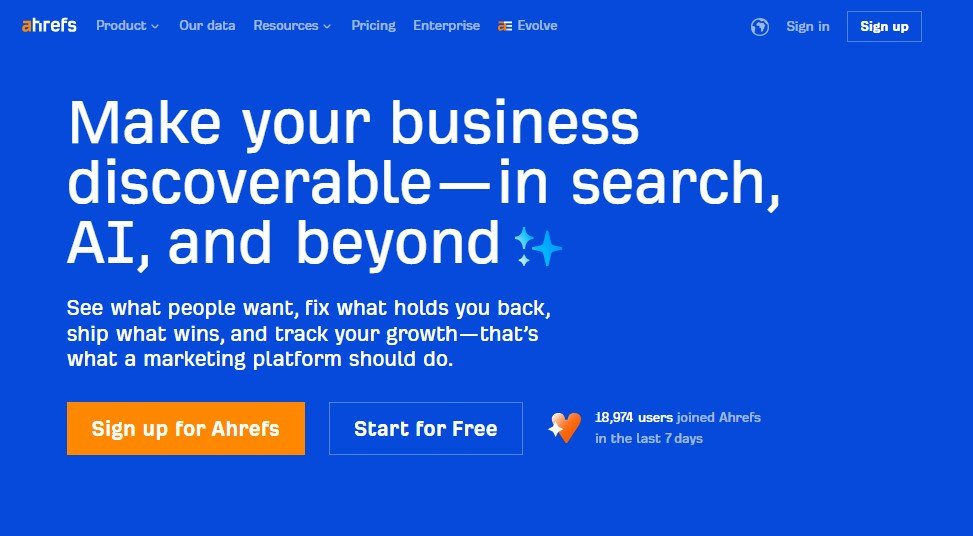
Features:
Ahrefs is one of the top-rated programmatic SEO tools for 2025, combining keyword research, SERP insights, backlink audits, and rank tracking. Its Keyword Explorer uncovers low-competition keywords ideal for programmatic content and product page targeting, making it a key player in scalable SEO software and tools.
| Pros | Cons |
| Keyword Explorer reveals long-tail and buyer-intent terms | Pricing starts at $99/month—costly for beginners |
| Excellent for expanding programmatic content at scale | Might be too advanced for basic keyword needs |
| Keyword Difficulty & traffic potential metrics are robust | Interface has a learning curve for new users |
| Powerful for backlink research and rank tracking | No free plan or trial offered |
Pricing:
- Lite – $129/month
- Standard – $249/month
- Advanced – $449/month
- Enterprise – $14,990/year
My Choice: Standard Plan. It balances project limits and access to key features like Keyword Explorer, Content Explorer, and Rank Tracker, supporting high-volume programmatic SEO workflows.
My Opinion:
Ahrefs is a cornerstone in my SEO chiefs powerful SEO tool kit. It’s not just for keyword discovery—it’s one of the best programmatic SEO tools customizable for analytics and product page scaling. I use it frequently when targeting long-tail niches or expanding into new content clusters across eCommerce and affiliate sites.
2. Semrush – All-in-One Tool for SEO and Content Planning
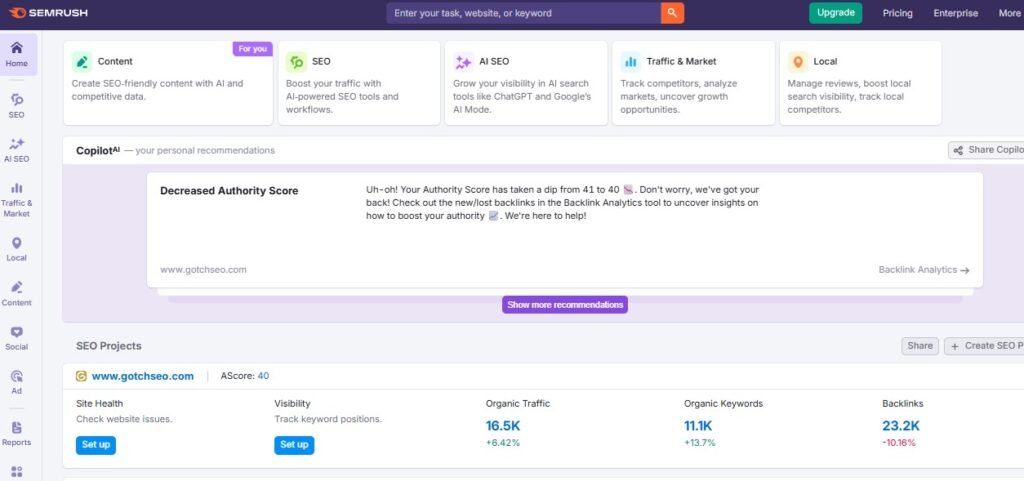
Features:
Semrush’s Keyword Magic Tool enables you to discover keyword clusters, analyze modifiers, and assess trends—all crucial for building scalable programmatic content strategies. It’s ideal for marketers who need a complete SEO software and tools platform for programmatic SEO campaigns in 2025.
| Pros | Cons |
| Keyword Magic Tool excels at finding long-tail opportunities | Interface is data-dense and may overwhelm beginners |
| Includes volume, trend, CPC, and difficulty metrics | Full feature access locked behind higher-tier plans |
| Strong competitor keyword gap and SERP analysis | Less intuitive than newer keyword tools |
| Supports full content planning and SEO audits | Limited searches on free plan |
Pricing:
- Pro – $117/month
- Guru – $208/month
- Business – Custom pricing
My Choice: Guru Plan. It allows deeper keyword tracking and more projects, supporting detailed programmatic SEO tools strategies and scaling efforts.
My Opinion:
Semrush is among the best keyword research tools for programmatic SEO and one of the most complete SEO platforms I’ve used. Its keyword clustering and competitor analysis are game-changers when scaling content. Despite its complexity, it’s one of the best programmatic SEO tools for analytics-driven marketers in 2025.
3. LowFruits – Find Easy-to-Rank Long-Tail Keywords
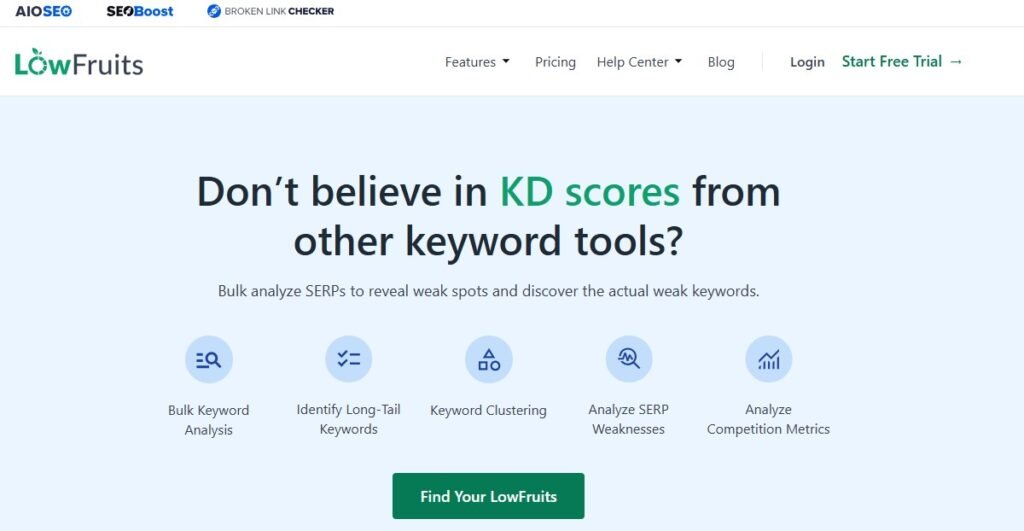
Features:
LowFruits targets low-competition, long-tail keywords by analyzing weak spots in SERPs, helping you uncover ranking opportunities fast. It’s especially effective for programmatic SEO content that requires scale without high competition—ideal for blogs and niche product pages.
| Pros | Cons |
| Finds weak SERP opportunities with minimal competition | No built-in SEO audit or backlink tools |
| Great for scaling content in competitive verticals | Fewer filtering options than Semrush or Ahrefs |
| Simple, intuitive interface for beginners | Keyword data may not be ideal for high-volume niches |
| Perfect for health and e-commerce SEO use cases | No keyword difficulty scoring or broader metrics |
Pricing:
- Starts at Standard – $21/month for 3,000 credits (pay-as-you-go).
- Premium – $62/month
My Choice: Pay-as-you-go. It’s perfect for targeted keyword discovery without committing to a subscription—ideal for campaign-specific research.
My Opinion:
LowFruits is a lightweight but sharp tool I turn to when I need fast, actionable keyword ideas with low competition. It’s helped me map out SEO strategies for niche health blogs and local commerce sites. While it lacks full-suite SEO features, its laser-focus on SERP gaps makes it one of the best keyword research tools for programmatic SEO beginners and solo marketers in 2025.
4. AnswerThePublic – Visual Keyword & Topic Mapping Tool
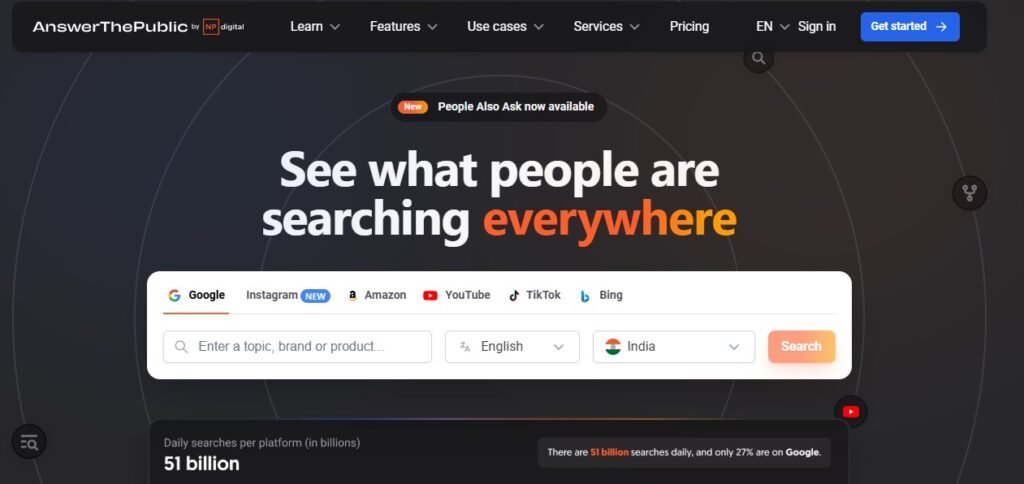
Features:
AnswerThePublic pulls keyword suggestions from Google, Bing, and YouTube, turning them into visual maps for easy content planning. It’s especially useful for generating question-based keyword clusters and FAQs for programmatic SEO at scale.
| Pros | Cons |
| Generates thousands of keyword variations instantly | Lacks SEO metrics like keyword difficulty or trends |
| Covers Google, Bing, and YouTube | Limited to basic data (volume and CPC) |
| Great for FAQs, comparison content, and topical clusters | Customer support responsiveness could be improved |
| Offers lifetime pricing options | Not a full-suite SEO platform |
| Location-based keyword filtering | No SERP analysis or backlink data |
Pricing:
- Individual: $5/month
- Pro: $49/month
- Expert: $99/month
My Choice: Individual Lifetime Plan. It’s affordable and perfect for long-term use, especially if you frequently ideate content for different niches.
My Opinion:
AnswerThePublic is one of my go-to tools in the early stages of programmatic SEO research. I use it to visualize keyword variations and FAQ-style content, particularly for health, SaaS, and local SEO campaigns. While it doesn’t offer deep analytics, it’s a brilliant idea generation tool that speeds up keyword mapping for large-scale content projects—earning its spot as one of the best keyword research tools for programmatic SEO in 2025.
Build Your Keyword Stack for Programmatic SEO Success
Using a combination of Ahrefs, Semrush, LowFruits, and AnswerThePublic, you can fuel your programmatic content engine with thousands of highly relevant keywords. These tools help you identify not just what users are searching—but how they search, making them essential additions to your SEO software and tools stack.
For SEOs aiming to scale intelligently, these are the top keyword tools that belong in any seo chiefs powerful SEO toolkit.
Reliable Data Scraping & Automation Tools for SEO Automation
To run a successful programmatic SEO campaign, you need structured data—and lots of it. Whether you’re scraping product specs, location data, FAQs, or pricing, automation tools help you scale your data input and feed it directly into your programmatic content engine.
Below are the most reliable programmatic SEO automation tools that simplify data scraping and workflow execution across your projects.
1. ScrapingBee – Scalable Web Scraping API for Structured Data
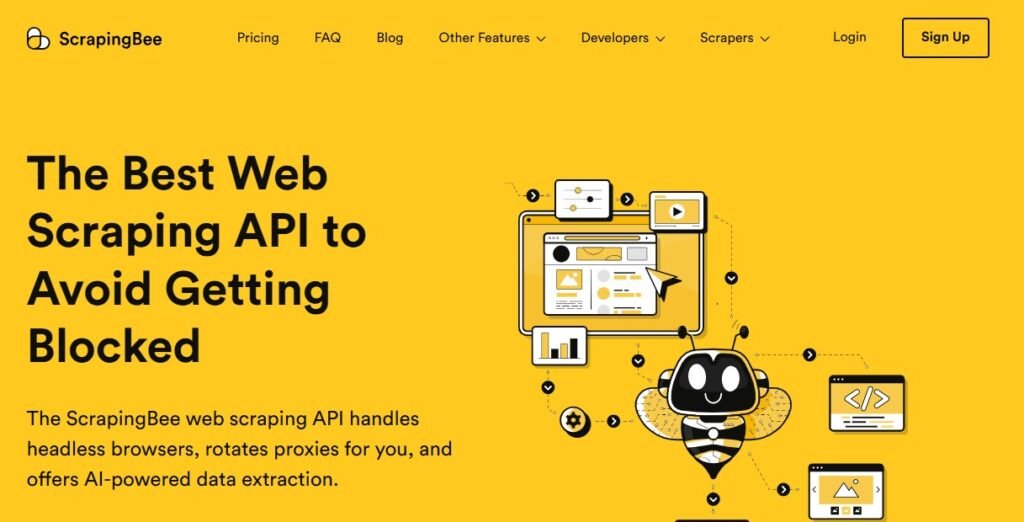
Features
ScrapingBee is a robust programmatic SEO tool built to extract structured website data at scale without being blocked. It supports proxy rotation, headless browsers, and JavaScript rendering, making it ideal for SEO automation and content planning.
| Pros | Cons |
| Bypasses bot detection and anti-scraping tech | Not beginner-friendly without coding knowledge |
| JavaScript rendering and headless browser support | Lacks GUI for quick setup |
| Scales with high-volume programmatic content scraping needs | May require custom scripts for complex tasks |
| Ideal for e-commerce and product page optimization | Slight learning curve for marketers without technical skills |
Pricing
ScrapingBee offers plans starting at $49/month for 250,000 API calls, with Startup at $99/month, Business at $249/plan, and Business+ at $599/plan. I chose the $99 Startup Plan for its balance of API volume and performance, ideal for scaling SEO automation.
My Opinion
I use ScrapingBee when building programmatic SEO content at scale, especially for e-commerce and health article optimization. It’s not flashy, but it’s part of my SEO Chiefs powerful SEO toolkit for a reason. Its ability to avoid IP bans and extract data consistently makes it perfect for scraping competitor product pages or pulling FAQs from niche forums. For 2025, this is one of the best programmatic SEO tools with customizable analytics capabilities—especially for developers or marketers working closely with coders.
2. Zapier – No-Code Workflow Automation for SEO Processes
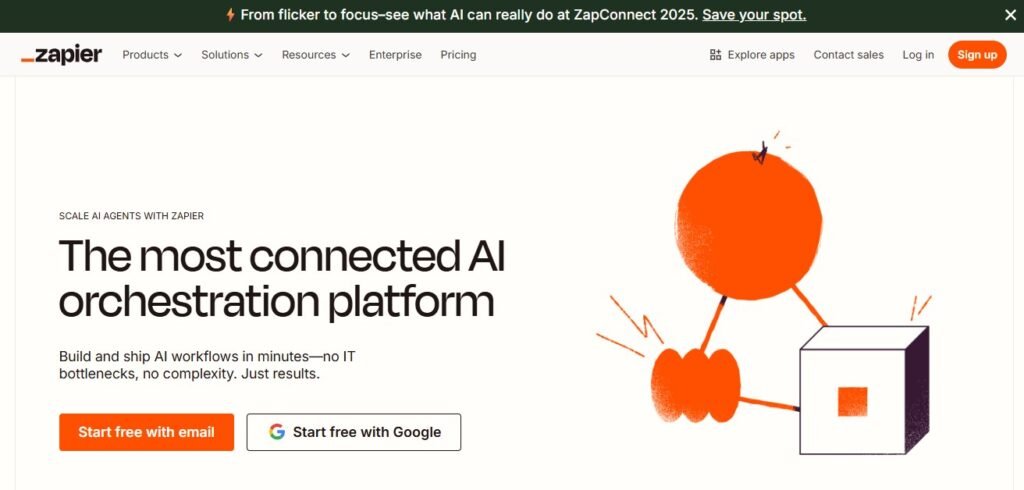
Features
Zapier is a no-code automation platform that connects programmatic SEO tools with apps like Google Sheets, CMSs, and AI writing tools. It helps automate content pipelines, data syncing, and performance reporting—without writing a single line of code.
| Pros | Cons |
| Seamless integration with 5,000+ apps and SEO platforms | Limited functionality on the free plan |
| Ideal for content automation in programmatic content workflows | Complex zaps can become hard to manage at scale |
| Great for connecting CMSs, analytics tools, and keyword platforms | Some SEO tools may need custom API handling |
| Enables real-time data sync for SEO dashboards | Slight learning curve for beginners unfamiliar with automation |
Pricing
Zapier offers a Free plan, Pro at $19.99/month, Team at $69/month, and Enterprise for large-scale automation. I used the Pro plan, which perfectly met my SEO workflow automation needs—triggering tasks between tools without writing code.
My Opinion
Zapier is the glue that holds many of my programmatic SEO automation tools together. I use it to push scraped keyword data from Airtable to CMSs, trigger content generation in Jasper, and even update analytics in real time. It’s especially valuable for tools for automating content creation for programmatic SEO, and one of the best low-code enablers in the seo chiefs powerful seo tool kit. If you’re scaling SEO without a dev team, Zapier is essential.
3. Bardeen – Smart Automation for Scraping and Task Execution
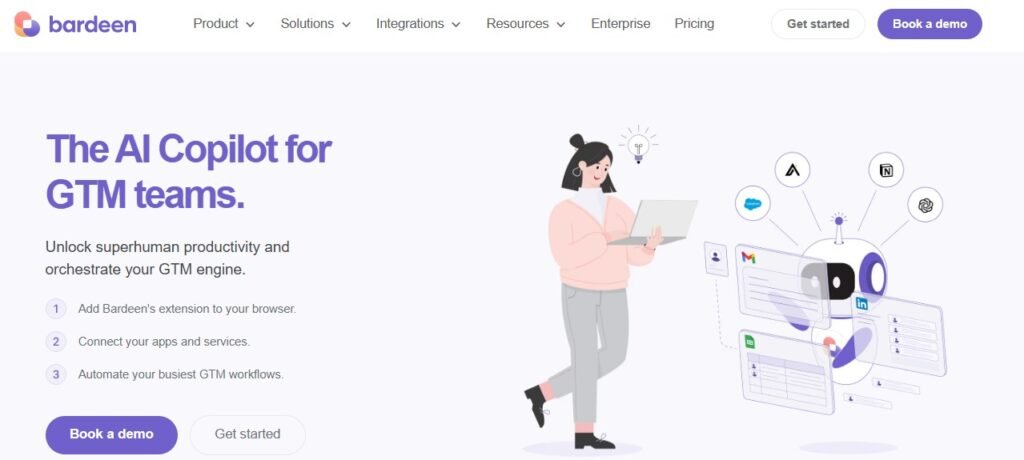
Features
Bardeen combines browser-based automation with smart scraping, enabling SEOs to extract data from SERPs or marketplaces and feed it directly into content templates or CMS editors. It’s a no-code, AI-powered solution ideal for scaling programmatic SEO automation tools.
| Pros | Cons |
| No-code AI scraping tool with visual workflows | Browser-dependent (runs locally) |
| Great for automating content creation for programmatic SEO | Limited integrations compared to Zapier |
| Easily fills CMS fields or Google Docs from scraped data | May require manual review for complex tasks |
| Speeds up repetitive SEO publishing routines | MacOS users have slightly better support |
Pricing
Bardeen offers Starter at $129/month, Teams at $500, and Enterprise from $1500. I chose the Starter plan, which efficiently handled my SEO automation needs—scraping data and automating repetitive tasks without code, saving hours on content scaling workflows.
My Opinion
Bardeen is a hidden gem in my seo software and tools stack. I use it when I need fast, visual automation without diving into scripts. It’s one of the best programmatic SEO tools for e-commerce pages that require frequent data updates, like product listings or SERP snippets. The scraping + action combo makes Bardeen perfect for tools for automating content creation programmatic SEO. If you’re into intuitive automation without developer overhead, Bardeen delivers.
Scrape Smarter, Publish Faster with Automation
When building data-heavy programmatic content, these automation tools save countless hours. Whether you’re using ScrapingBee for harvesting content, Zapier for workflow connections, or Bardeen for on-the-fly scraping, each tool adds massive value to your programmatic SEO automation toolkit.
For those asking about tools for automating content creation programmatic SEO, this trio should be your starting point.
Data Syncing & Workflow Automation Tools
Managing structured data is a cornerstone of effective programmatic SEO. When you’re generating thousands of pages using datasets like product info, city names, or customer reviews, keeping everything in sync is non-negotiable. That’s where data syncing tools become essential.
Below are the top programmatic SEO tools automation features 2025 that help maintain data accuracy across your entire content pipeline.
1. Whalesync – Effortless Two-Way Syncing for Programmatic SEO Workflows
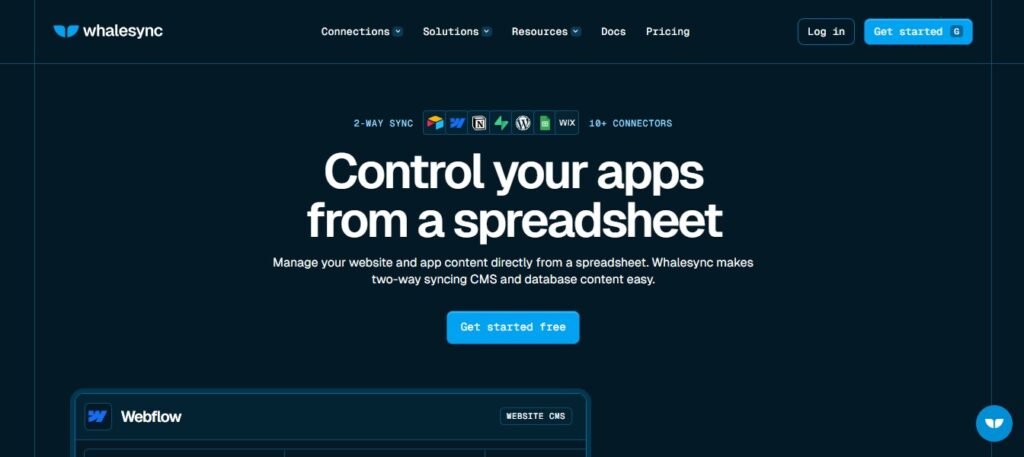
Features:
Whalesync enables two-way, real-time data syncing between tools like Airtable, Google Sheets, Webflow, and Shopify—no coding required. It maps fields seamlessly, letting you push structured content into CMS platforms to automate programmatic content publishing.
| Pros | Cons |
| Two-way sync with real-time updates | Limited support for CMS platforms |
| No-code setup for fast onboarding | No support for custom automation logic |
| Excellent documentation and support | Only integrates with selected tools |
| Logs sync issues effectively | – |
Pricing Options:
Whalesync offers Personal at $5, Starter at $20, Plus at $40, and Pro at $200/month. I used the Starter plan, which smoothly synced data between tools, streamlining my programmatic SEO workflows without complex setup or coding.
My Opinion:
For anyone starting with programmatic SEO tools, Whalesync is a game-changer. Its no-code two-way sync fills the automation gap between databases and CMS platforms. If you’re optimizing product pages or Shopify content, it’s one of the best programmatic SEO tools for 2025 in terms of ease and performance.
2. Airtable – The Backbone of Structured SEO Data
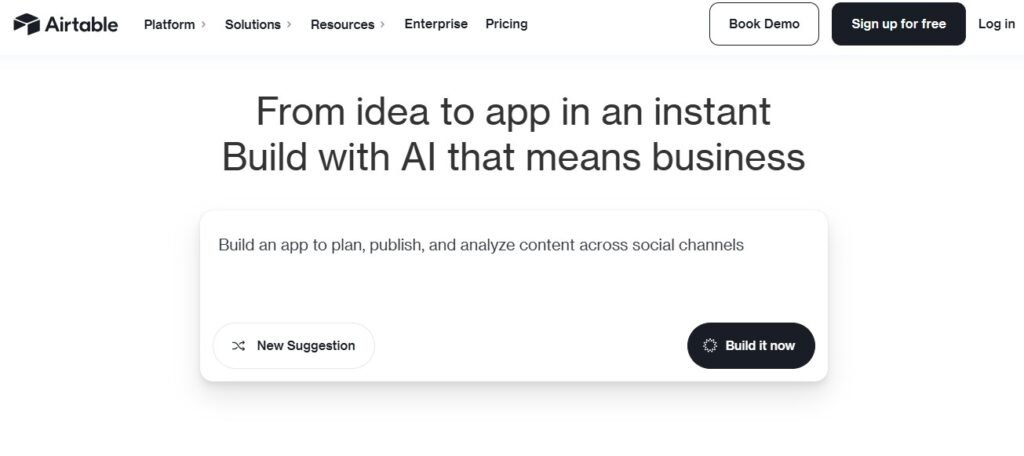
Features:
Airtable blends spreadsheet simplicity with database functionality, ideal for managing structured SEO data. It offers custom views, third-party integrations like Zapier and Whalesync, and supports various field types to build scalable programmatic SEO templates for product pages, topic clusters, or health articles.
| Pros | Cons |
| Highly customizable database structures | Limitations on records and database size in free plan |
| Easy collaboration between SEO and content teams | File size attachment restrictions |
| Integrates well with CMS tools like Webflow | Requires setup time for beginners |
| Supports automation via Zapier and Whalesync | Not ideal for unstructured data workflows |
| Ideal for programmatic SEO tools automation features 2025 | Advanced features locked behind higher plans |
Pricing
- Free Plan: Up to 1,000 records/base, 5 editors
- Team Plan: $20/month – I chose this for unlimited collaborators and automations
- Business Plan: $45/month – Ideal for enterprise usage
- Enterprise Plan: Custom pricing
For my workflow, I picked the Team Plan as it balances power and cost. It’s scalable enough to handle structured programmatic content databases, especially when working on Shopify or Webflow-based SEO automation.
My Opinion
Airtable is hands-down one of the best programmatic SEO tools for e-commerce, health blogs, and scalable CMS setups. If you’re trying to optimize product pages or automate content generation, its ability to sync with Webflow or WordPress is unmatched. As a marketer, I’ve used it as my primary hub to manage keyword variations, H1s, meta descriptions, and automate content pipelines using OpenAI and Whalesync. For those looking into programmatic SEO tools automation features 2025, Airtable will likely be your control tower.
Why Data Syncing Matters for Programmatic SEO
When deploying large-scale programmatic content, any mismatch between your source data and your live pages can hurt SEO performance, user trust, and internal workflows. With tools like Whalesync and Airtable, you ensure:
- Consistent metadata and content across all generated pages
- Up-to-date product or service listings
- Accurate schema implementation for organic visibility
Plus, if you’re working with multiple clients or high-volume publishing schedules, these tools also help you track programmatic SEO tools volume-based pricing benchmarks analytics—giving you insights into production costs, time savings, and ROI.
Visual & Image Generation Tools for Programmatic Pages
When it comes to programmatic content, visuals matter just as much as the text. Whether you’re generating thousands of blog thumbnails, product banners, or dynamic social preview images, using the right SEO software and tools for image automation helps enhance user experience and SEO rankings.
Below are the top tools to auto-generate visuals for SEO landing pages, especially useful for Shopify, affiliate, and content-heavy sites.
1. Placid – Automated Visual Generation for Programmatic Content
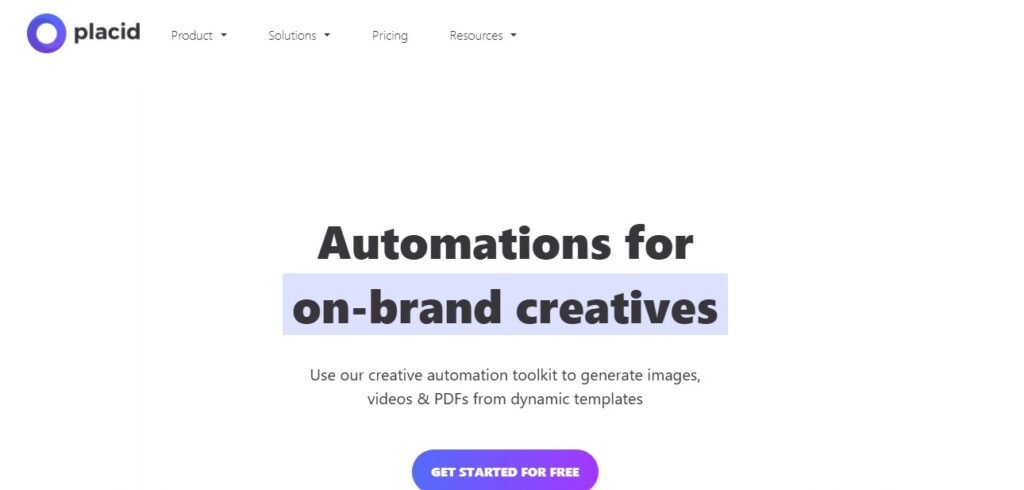
Features:
Placid automates image generation by connecting with Airtable. It transforms your database records into dynamic visuals using custom templates, including text, images, and logos—perfect for building branded visuals at scale for programmatic SEO pages.
| Pros | Cons |
| Easy integration with Airtable | Limited to image generation only |
| Supports dynamic text and logos | No native CMS sync |
| Ideal for social previews & Open Graph images | Slight learning curve for template setup |
| Scales image creation for large datasets | – |
Pricing Options:
- Basic (Approx. $19/month): Limited templates and API calls
- Pro Plan – $39/month & Business – $89/month- Higher API limits, advanced features
I went with the Basic plan, as it’s perfect for automating social images for blog articles and health and wellness pages without needing heavy customization.
My Opinion:
Placid is one of the top programmatic SEO tools for automating branded image generation. While it doesn’t offer analytics or CMS sync, its visual automation power supports Open Graph images and enhances page previews—especially valuable for e-commerce product pages and content visibility in 2025.
2. Canva – Visual Automation & Template Scaling for SEO Content
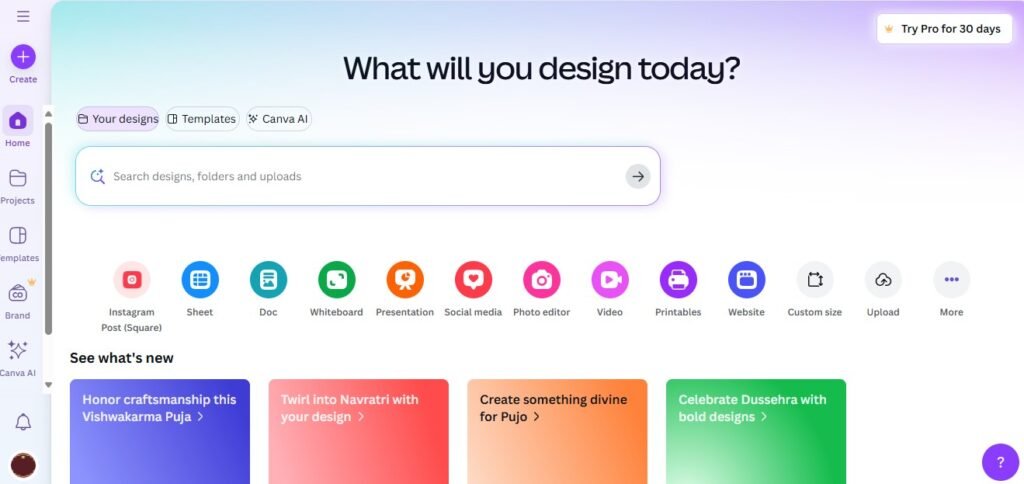
Features:
Canva blends intuitive design with automation. Using its API, Whiteboard tool, and bulk-edit features, you can create hundreds of visuals from templates using datasets—ideal for automating graphics across programmatic content pages like blog posts, e-commerce listings, or affiliate roundups.
| Pros | Cons |
| User-friendly for beginners | Limited API access on free plan |
| Supports bulk image generation with datasets | Some layout tools feel restrictive |
| Ideal for branding and scalable visuals | API setup requires some learning |
| Works well for wireframing templates too | – |
Pricing Options:
- Free Plan: Access to basic features, limited templates
- Canva Pro ($4000/year): Advanced brand tools, bulk creation, API access
- Canva Teams ($4000/year and can be customised)
- Enterprise – Contact the Sales for pricing
I use the Pro plan since it’s affordable and enables bulk visual generation—great for SEO automation across product pages and health articles.
My Opinion:
Canva may not be a traditional programmatic SEO software, but with its API and bulk visual automation, it’s one of the best tools for programmatic SEO e-commerce. It ensures brand consistency, improves page speed with web-optimized exports, and pairs perfectly with other SEO software and tools in my toolkit.
3. Figma – Scalable Visual Design for Programmatic SEO Systems
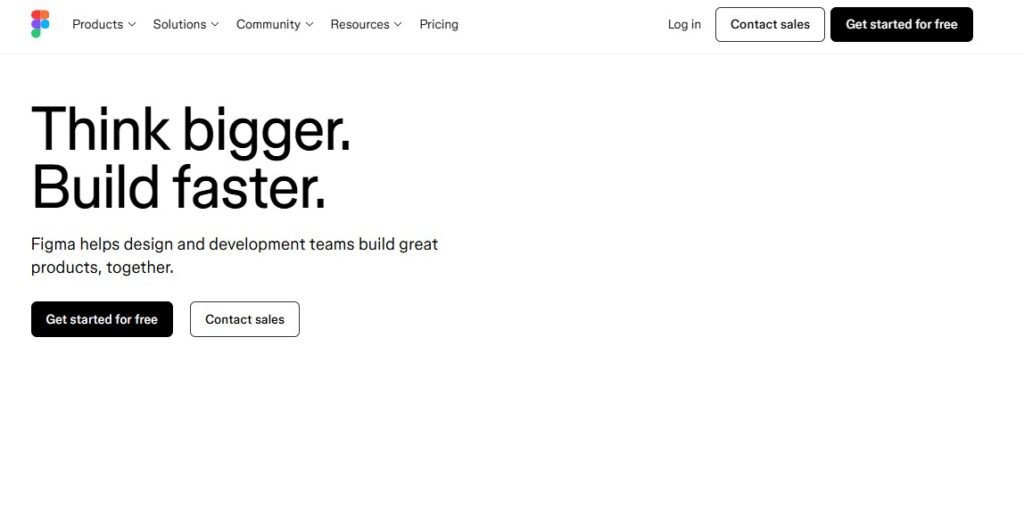
Features:
Figma allows teams to build reusable visual components for SEO templates—banners, CTAs, product cards—making it ideal for designing scalable, consistent assets across programmatic content pages. With plugins or integrations, you can even automate export-ready frames.
| Pros | Cons |
| Great for collaborative design | No native automation for image generation |
| Reusable design systems scale efficiently | Requires plugins for automation |
| Excellent for SEO-focused wireframes | Learning curve for non-designers |
| Integrates well with tools like Placid | – |
Pricing Options:
- Free Plan: Ideal for wireframing and solo design
- Professional ($12/editor/month): Team libraries and design systems
I use the Professional plan—it supports collaborative SEO page layout planning and integrates easily with image automation tools like Placid for visual scaling.
My Opinion:
While Figma isn’t a direct programmatic SEO tool, it’s essential for visual systematization. If you’re building templates for Shopify, affiliate, or health and wellness blogs, Figma offers unmatched design flexibility and collaboration—making it one of the best design tools for programmatic SEO automation in 2025.
4. Tailgraph – Data Visualization for Programmatic SEO Pages
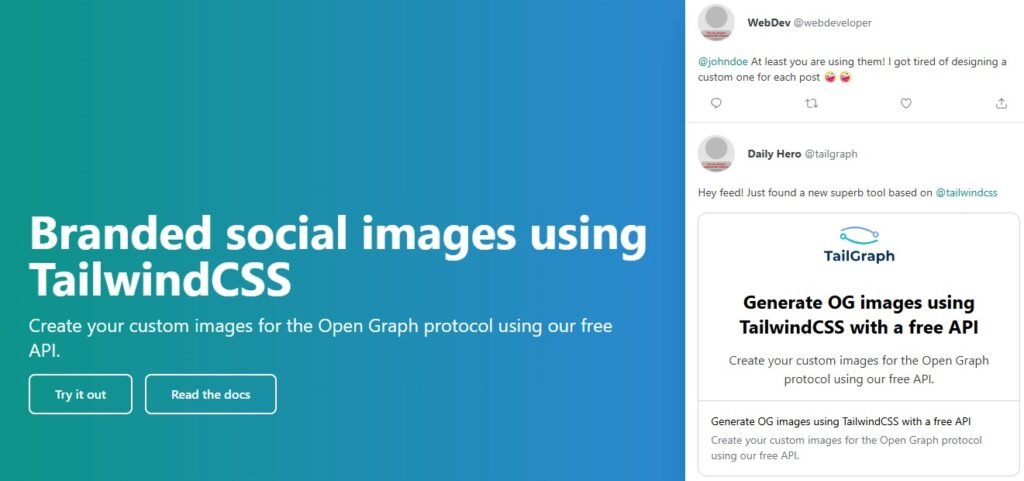
Features:
Tailgraph transforms raw data into visual reports, charts, and infographics—ideal for embedding into programmatic SEO pages. It supports Google Sheets integration, enabling bulk visual creation using formulas like CONCATENATE for automating featured images or comparison visuals.
| Pros | Cons |
| Converts data into charts & infographics | No real-time sync with CMS platforms |
| Works with Google Sheets for automation | Manual setup for template customization |
| Great for comparison and stat-rich content | No API for advanced automation |
| Enhances trust with visual proof | – |
Pricing Options:
- Free Tier: Limited exports and visual types
- Custom Paid Plans: Tailored features depending on usage volume
I opted for the Free plan initially—it’s sufficient for visualizing product stats or embedding finance data on programmatic content pages without heavy usage.
My Opinion:
Tailgraph is one of the top-rated programmatic SEO tools 2025 for data-driven visuals. Whether it’s product performance charts for e-commerce or stat infographics for health blogs, this tool adds credibility and improves engagement—an essential addition to any SEO chief’s powerful SEO tool kit.
Visuals Drive SEO Engagement and Conversions
If you’re looking for the best programmatic SEO tools for Shopify content automation 2025, these design tools play a crucial role. Shopify merchants, affiliate marketers, and SaaS bloggers can all benefit from auto-generating visuals that support user intent, boost dwell time, and improve click-through rates.
Pairing strong visuals with templated copy ensures your programmatic content looks just as good as it reads—without spending hours designing one-off assets.
Analytics & Tracking Tools for Measuring SEO Performance
Once your programmatic content is live, measuring its impact becomes crucial. The ability to track performance across thousands of pages requires more than just basic traffic metrics—you need customizable analytics 2025 tools that are privacy-compliant, scalable, and tailored to SEO.
Below are some of the best programmatic SEO tools customizable analytics 2025 that help you stay on top of rankings, engagement, and ROI.
1. Plausible – Lightweight SEO Analytics for Programmatic Pages
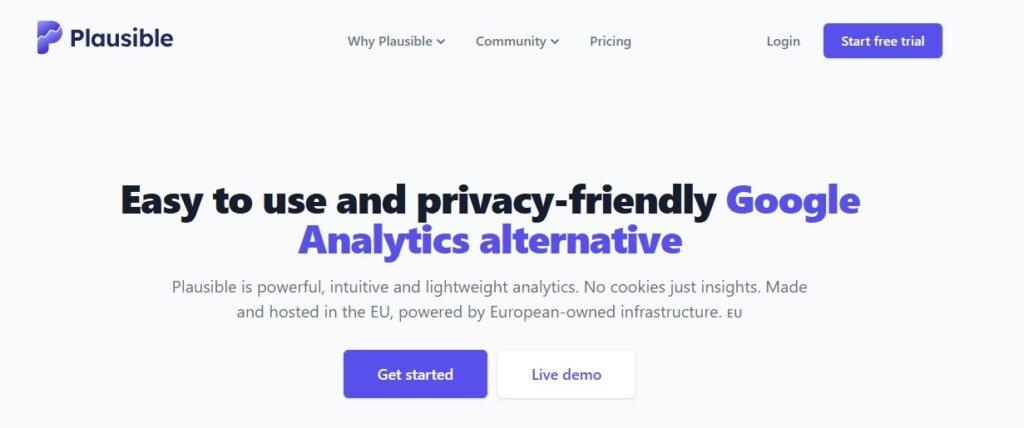
Features:
Plausible offers privacy-focused, cookie-free analytics that track SEO performance across programmatic pages with zero bloat. It integrates with Google Search Console to surface query-level insights, referrer sources, and traffic to templated URLs—perfect for content performance analytics 2025.
| Pros | Cons |
| Clean UI with real-time SEO metrics | No heatmaps or session recordings |
| Page-level insights without sampling | Limited goal tracking vs. GA |
| Fast-loading and lightweight | Smaller ecosystem for integrations |
| Excellent for client SEO dashboards | – |
Pricing Options:
- Starts at $9/month: For small sites (under 10k views)
- Growth Plan at $14/month
- Business plan at $19/month
- Scaled pricing: Increases with traffic volume
I chose the $9/month plan because it fits well with my programmatic SEO tools stack for tracking templated pages and maintaining performance visibility for health and affiliate content.
My Opinion:
Plausible is one of the best programmatic SEO tools for customizable analytics 2025, especially for privacy-first websites. It strips away complexity and focuses on what matters—SEO metrics, referrers, and clean dashboards. It’s a lightweight gem that every SEO software and tools stack should include.
2. Matomo – Self-Hosted Analytics for Programmatic SEO at Scale
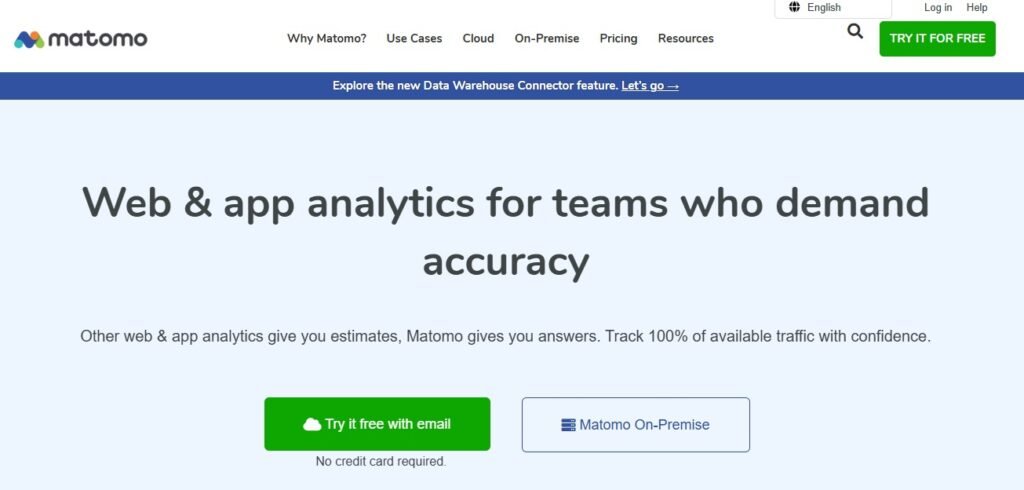
Features:
Matomo is a powerful on-premise web analytics tool offering deep customization and user privacy. It provides detailed segmentation by keyword, device, and behavior—making it perfect for analyzing performance across thousands of programmatic SEO URLs with complete data ownership.
| Pros | Cons |
| Full data ownership and privacy | Requires technical setup and hosting |
| Keyword & location-based segmentation | More complex than SaaS alternatives |
| Custom event tracking for UX insights | Limited plug-and-play integrations |
| Integrates with Google Search Console | – |
Pricing Options:
- Self-Hosted (Free): Full features, hosted on your own server
- Cloud Hosting (from Rs 1690/month): Managed hosting with all features
I use the Self-hosted version, which offers enterprise-grade SEO tracking without sharing data externally—ideal for programmatic content projects in health, SaaS, or finance sectors.
My Opinion:
Matomo stands out among the top programmatic SEO tools for customizable analytics in 2025. It’s ideal if you need granular event tracking, keyword data, and ethical analytics. For SEO professionals handling large, template-driven content, it’s a powerful and privacy-first choice in the SEO software and tools stack.
3. GA4 (Google Analytics 4) – Event-Based Tracking for Programmatic SEO Pages
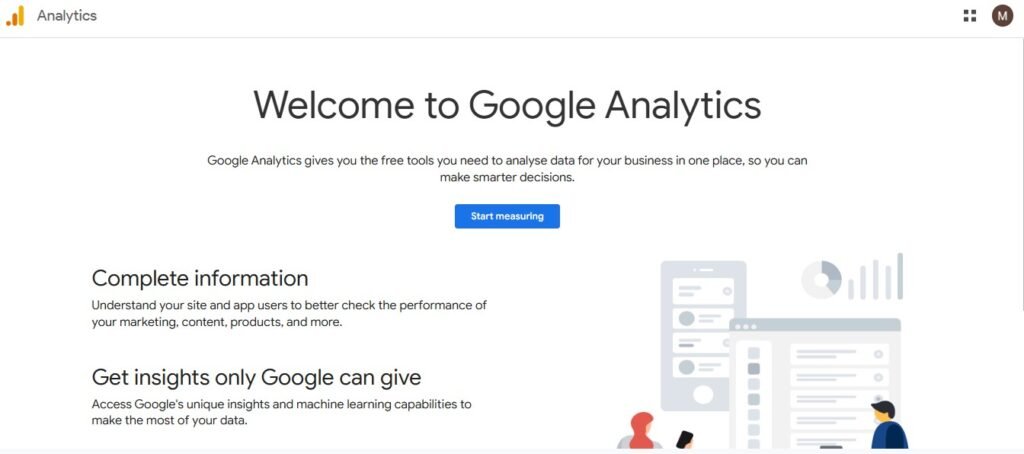
Features:
GA4 uses an event-driven data model to track user engagement on programmatically generated pages. It supports custom conversions, CTA tracking, and device-level analysis—making it ideal for high-volume SEO campaigns with dynamic content across multiple templates.
| Pros | Cons |
| Robust tracking across devices | Steep learning curve for beginners |
| Custom event and goal setup | Limited reporting unless configured |
| Native integration with GSC and Google Ads | Data sampling on large sites |
| Free to use with extensive documentation | – |
Pricing Options:
- Free: Full-featured web and app analytics
- GA4 360 (Enterprise-level): Custom pricing for larger organizations
I use the free version, which is more than sufficient for tracking performance of programmatic content, product pages, and SEO funnels across affiliate and e-commerce websites.
My Opinion:
GA4 remains one of the best programmatic SEO tools 2025 for comprehensive traffic monitoring. Its event-based system offers detailed insight into content performance, user journeys, and conversions. Paired with GSC, it’s still the cornerstone of any serious SEO software and tools stack.
4. Google Search Console – Direct SEO Insights for Programmatic Pages
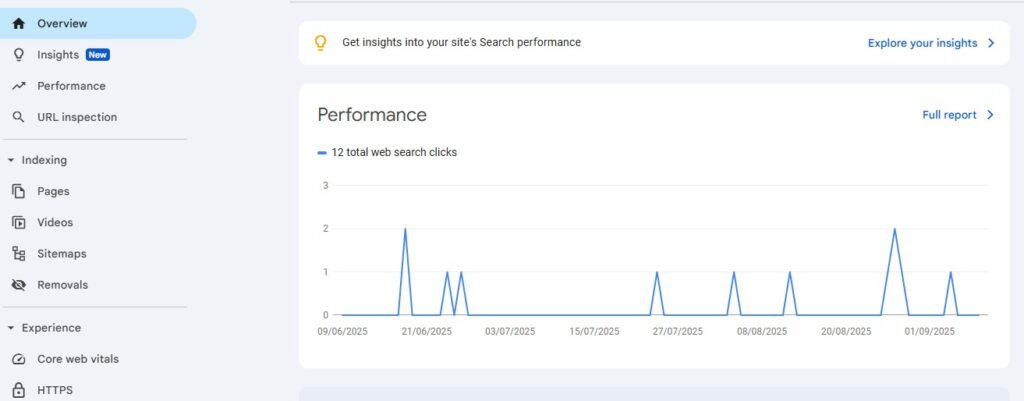
Features:
Google Search Console provides query-level SEO data straight from Google. It allows you to monitor clicks, impressions, rankings, and indexing across thousands of programmatic content pages, helping you understand which URLs and templates perform best in organic search.
| Pros | Cons |
| Tracks impressions, clicks, and positions | No on-site behavior tracking |
| Monitors page and query-level SEO performance | Limited customization of dashboards |
| Helps troubleshoot indexing and sitemap issues | Historical data is limited to 16 months |
| Essential for tracking content visibility | – |
Pricing Options:
- Completely Free: Available to all verified site owners
No pricing tiers here. I rely on GSC’s free version daily to measure organic performance of category, location, and health-related SEO pages—especially across programmatic SEO campaigns.
My Opinion:
Google Search Console is non-negotiable in any SEO chief’s powerful SEO toolkit. It’s one of the best programmatic SEO tools for content performance analytics in 2025, especially when monitoring query clusters for dynamic URLs. No other tool gives such accurate organic visibility straight from the source.
Measure What Matters at Scale
As your programmatic SEO deployment grows, so does your need for scalable reporting. These tools—Plausible, Matomo, GA4, and GSC—make it easy to measure what matters: organic growth, content engagement, and technical visibility.
The best programmatic SEO tools customizable analytics 2025 not only track performance but help you refine your strategy for greater ROI. Don’t just publish at scale—optimize at scale, too.
Indexing & Technical SEO Tools
Creating programmatic content at scale is only half the battle—getting it indexed quickly and correctly is where technical SEO comes in. Without proper indexing, even the most optimized pages can sit in limbo, invisible to users and search engines.
Here are two essential SEO optimization tools every marketer should include in their programmatic SEO software stack to ensure high crawlability and fast indexing.
1. IndexNow – Real-Time Indexing for Programmatic SEO Pages
Features:
IndexNow is an instant indexing protocol that alerts search engines like Bing and Yandex whenever you publish or update URLs—crucial for fast-tracking the discovery of programmatically generated content. It reduces crawl budget waste by focusing only on changed or new pages.
| Pros | Cons |
| Real-time notification to search engines | Not yet fully adopted by Google |
| Improves indexing speed for large websites | Limited search engine support |
| Reduces crawl budget waste | Setup can be technical for some |
| Integrates with plugins like Yoast, RankMath | – |
Pricing Options:
- Free Protocol: Integrated into many SEO plugins or via API
I use it via RankMath’s free integration, which works well for notifying Bing and Yandex about frequent updates across e-commerce and affiliate SEO pages.
My Opinion:
IndexNow is a must-have for scaling technical SEO in programmatic setups. While it doesn’t yet cover Google, its value for faster indexing of new templates and updated content can’t be overstated. It’s one of the best programmatic SEO tools 2025 for improving search visibility without added crawl costs.
2. Screaming Frog – Technical SEO Crawler for Scalable Programmatic Pages
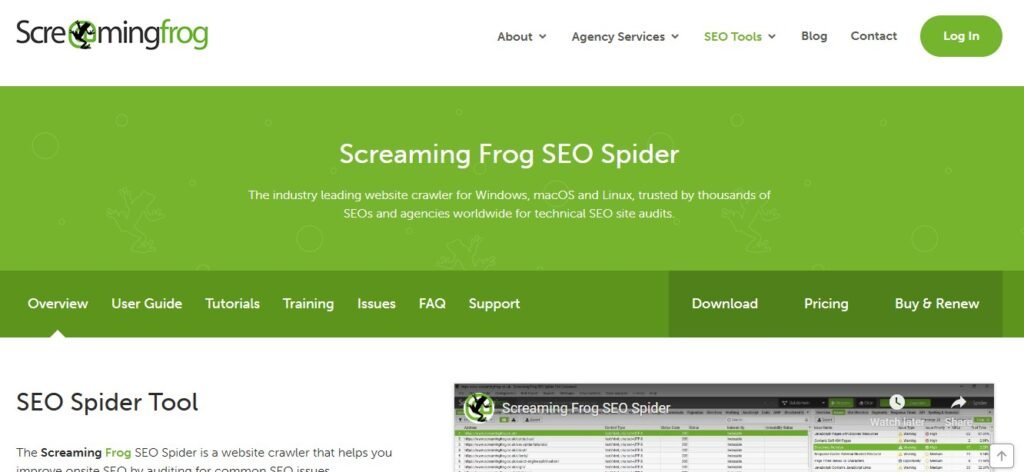
Features:
Screaming Frog is a powerful desktop crawler that scans your website for technical SEO issues. It identifies broken links, duplicate metadata, and thin content—critical for auditing programmatic SEO pages before publishing at scale.
| Pros | Cons |
| Free version available | Steep learning curve for beginners |
| JavaScript rendering and structured data checks | Can be resource-intensive on large sites |
| Custom reports for SEO auditing | Lacks real-time cloud-based collaboration |
| Works on Windows, Mac, Linux | – |
Pricing Options:
- Free Plan: Crawl up to 500 URLs
- Paid License ($279/year): Unlimited crawling, JavaScript rendering, advanced reports
I use the paid plan because it unlocks deep crawl capabilities needed for auditing thousands of programmatic SEO pages and fixing duplicate content or metadata issues.
My Opinion:
Screaming Frog is an essential part of any SEO software and tools stack in 2025. Whether you’re building health blogs, product landing pages, or affiliate content, this tool ensures technical accuracy and crawlability. It’s one of the best programmatic SEO tools for avoiding duplicate and thin content at scale.
Why Indexing & Technical Optimization Matter in Programmatic SEO
You can’t afford to overlook the features of programmatic SEO tools for organic traffic if your goal is sustainable growth. Even the most intelligently generated content won’t rank unless it’s:
- Properly crawled and indexed
- Structured for optimal readability
- Free from technical errors that block visibility
With IndexNow and Screaming Frog, you can ensure that every piece of programmatic content is not only published but also performing.
CMS & Site Builders Compatible with Programmatic SEO
Your choice of CMS or site builder can make or break the scalability of a programmatic SEO strategy. To launch thousands of SEO-optimized pages efficiently, you need platforms that support dynamic content, custom routing, structured data, and integrations with automation tools.
Here are the best programmatic SEO tools for CMS integration that help streamline publishing and performance—especially for non-developers looking for low-code site builders.
1. Webflow – CMS-Driven Site Builder for Scalable Programmatic SEO
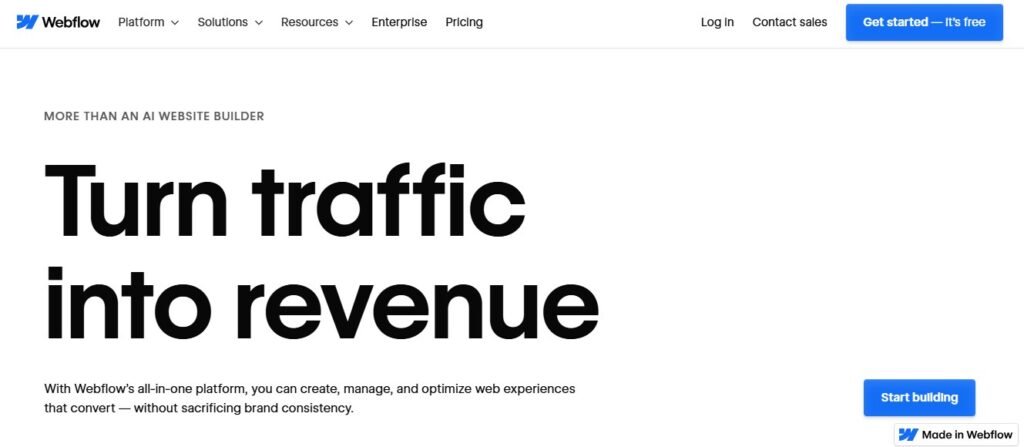
Features:
Webflow combines visual design flexibility with a powerful CMS that enables dynamic, template-based page creation. With built-in SEO settings and integrations like Whalesync, it’s one of the top low-code site builders for automating programmatic SEO at scale.
| Pros | Cons |
| Clean, semantic code output for SEO | Steep learning curve for beginners |
| Dynamic content via CMS collections | Limitations on traffic and CMS items |
| Built-in SEO features (meta, schema) | Can become expensive as you scale |
| Works seamlessly with Airtable & APIs | – |
Pricing Options:
- Starter (Free): 2 pages, 50 CMS items
- Basic ($14/month): Custom domain, 150 pages
- CMS ($23/month): 2,000 CMS items, 1,000 form submissions
- Business ($39/month): 10,000 CMS items, 10 editors
- Enterprise: Custom pricing
I use the CMS plan, which hits the sweet spot for running structured programmatic content campaigns for local and health niches without overpaying.
My Opinion:
Webflow is hands-down one of the best programmatic SEO tools for CMS integration in 2025. Its templating, clean code, and design control help build scalable SEO pages without dev dependency. It’s my go-to programmatic site builder for e-commerce, affiliate, and long-tail content ecosystems.
2. WordPress – The Most Flexible CMS for Programmatic SEO Integrations
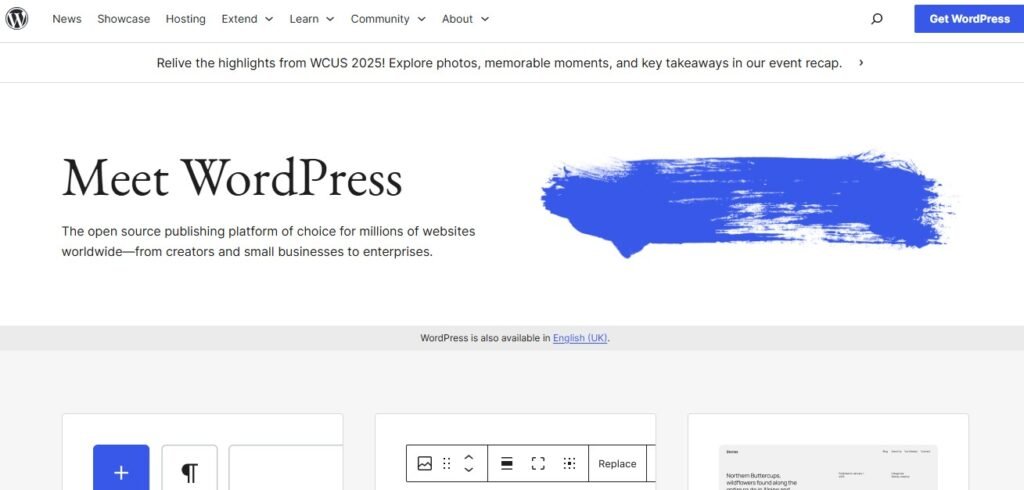
Features:
WordPress powers over 40% of the web and offers unmatched customizability for programmatic SEO. When paired with tools like ACF, WP All Import, and custom post types, you can automate dynamic content creation at scale with total control over SEO elements.
| Pros | Cons |
| Unlimited plugin ecosystem | Requires plugin maintenance and updates |
| Full control over SEO settings and structure | Can get bloated with excessive plugins |
| Supports ACF, CPT UI, WP All Import for automation | Performance issues without proper optimization |
| Easily integrates with APIs and headless CMS | – |
Pricing Options:
- Free CMS core
- Hosting and premium plugins/themes vary widely
(e.g., Elementor Pro ~$59/year, WP All Import ~$99 one-time)
My Opinion:
I turn to WordPress when I need complete control over every element of a programmatic SEO project—from schema to templated design. Its plugin stack makes it ideal for importing large datasets, optimizing on-page SEO, and integrating external APIs. It’s not as fast to deploy as Webflow, but for complex, layered content ecosystems, WordPress is irreplaceable. Definitely one of the best CMS platforms for power users doing serious programmatic SEO work.
Choosing the Right Low-Code CMS for Your SEO Stack
So, what are the top low-code site builders that integrate well with programmatic SEO tools? Webflow and WordPress both stand out—but serve different needs.
- Choose Webflow if you want an elegant, visual-first, no-code workflow.
- Choose WordPress if you need flexibility, scale, and deeper backend control.
Either way, the right CMS helps you maintain a consistent publishing cadence while keeping SEO best practices embedded in every page—crucial when deploying high-volume programmatic content.
Top Programmatic SEO Tools for Specific Use Cases
Not every programmatic SEO strategy is created equal. The tools you choose should align with your niche—whether it’s high-volume e-commerce catalogs or medically accurate health articles. Below, we highlight the best programmatic SEO tools for e-commerce websites and health & wellness blogs to help you tailor your toolstack to your vertical.
1. E-Commerce & Shopify Content Automation
If you’re managing a store with hundreds (or thousands) of SKUs, templates, or product variants, programmatic SEO becomes essential. The key is to combine structured product data with automated tools that support product page optimization and scale.
Best tools for this use case:
- Jasper: Ideal for generating optimized product descriptions with AI templates tailored to buyer intent.
- Placid: Automates product image creation using SKU or category data, perfect for Shopify.
- Whalesync + Airtable: Use them to sync your Shopify data into Webflow or WordPress for templated content publishing.
- LowFruits: Excellent for uncovering long-tail product search terms that you can plug into your page templates.
Why use them? These are the best programmatic SEO tools for e-commerce that help reduce duplicate content, improve indexing, and enhance SEO performance at the SKU level.
2. Health & Wellness Content Optimization
For health blogs and wellness publishers, SEO challenges are unique. Content needs to be accurate, compliant, and often written at scale. Programmatic SEO helps you deploy condition-based landing pages, symptom checkers, and location-targeted pages.
Best tools for this use case:
- Frase: Great for creating health article templates optimized with data from top-ranking pages.
- ChatGPT: Can assist with first drafts of educational content when prompted with structured health data.
- GA4 + GSC: Help track how each template variation is performing in terms of impressions, CTR, and average position.
- Screaming Frog: Ensures your health pages are technically optimized and crawlable.
Why use them? These are the best programmatic SEO tools for health and wellness blogs 2025—great for building authority, improving page relevance, and helping users find trustworthy information.
Niche-Specific SEO Requires Tailored Tools
Whether you’re selling fitness gear or publishing guides on managing chronic conditions, your programmatic SEO tools should serve your content type and audience intent.
- For Shopify and WooCommerce sites, the focus is product page optimization at scale.
- For health publishers, it’s about optimizing health articles for expertise, trust, and information accuracy.
By pairing the right tools with the right use case, you’ll build better content—and stronger SEO outcomes.
Comparison of Top-Rated Programmatic SEO Tools in 2025
Choosing the right tool isn’t just about features—it’s about fit. As more brands adopt scalable SEO strategies, understanding how the top-rated programmatic SEO tools 2025 compare in terms of usability, performance, and pricing has never been more important.
Here’s a quick programmatic SEO tools comparison to help you make the right decision based on your workflow, budget, and technical skill level.
1. Jasper vs. ChatGPT – AI Writing Assistants for Scalable Content
- Ease of Use: Jasper’s template-based UX is beginner-friendly. ChatGPT offers flexibility but requires structured prompts.
- Performance: Both excel in generating bulk content, but Jasper has more SEO-focused templates and integrates easily with Surfer SEO.
- Pricing: Jasper uses tiered plans based on word count. ChatGPT (Pro version) is flat-priced but less optimized for SEO out of the box.
Best for: Marketers focused on fast, SEO-optimized content for product pages and blog posts.
2. Frase vs. Surfer SEO – Content Optimization for SERP Relevance
- Ease of Use: Frase is intuitive and ideal for research and outline building. Surfer SEO is slightly more technical but offers deeper keyword analysis.
- Performance: Frase shines in topic coverage, while Surfer is stronger at on-page SEO scoring and real-time SERP data.
- Pricing: Frase is more affordable for small teams. Surfer offers better value for larger content ops with its integration into workflows.
Best for: SEO teams optimizing at scale with a balance between content depth and ranking precision.
3. Airtable vs. Webflow CMS – Data Management vs. Deployment
- Ease of Use: Airtable is spreadsheet-simple but powerful. Webflow has a visual interface with a steeper learning curve.
- Performance: Airtable excels at structured data management; Webflow automates template-based page deployment beautifully.
- Pricing: Airtable is cost-effective at small scale; Webflow becomes pricier but delivers complete front-end control.
Best for: Teams managing massive datasets and syncing them into SEO-friendly site structures.
4. Screaming Frog vs. IndexNow – Technical SEO & Indexing Support
- Ease of Use: Screaming Frog has a learning curve but offers deep insights. IndexNow is plug-and-play with minimal setup.
- Performance: Screaming Frog helps diagnose crawl issues; IndexNow speeds up indexing across supported search engines.
- Pricing: Screaming Frog is a one-time license; IndexNow is free (via API or plugin).
Best for: Technical SEOs and webmasters managing indexing and crawlability at scale.
Which Tool Is Right for You?
When evaluating how do different programmatic SEO tools compare in terms of user-friendliness and performance, it comes down to your needs:
- Ease of use: Jasper, Airtable, IndexNow
- Advanced performance: Screaming Frog, Surfer SEO, Webflow
- Budget-friendly: ChatGPT, Frase, IndexNow
This programmatic SEO tools comparison makes it clear—no single tool does it all. The most successful SEO teams in 2025 are those who combine top-rated programmatic SEO tools 2025 into a flexible, integrated stack.
Conclusion: Build Your Scalable SEO Engine with the Right Tool Stack
The success of your programmatic SEO strategy hinges on the tools you choose. From keyword discovery to content automation and indexing, each tool plays a distinct role in building a scalable, search-optimized content engine. This final section wraps up how to align your business goals with the best programmatic SEO tools on the market.
Summary: Matching Tools to Strategy
Whether you’re a solo marketer or part of a larger team, matching your toolstack to your strategic needs is critical. Here’s a quick breakdown based on common use cases:
- Content Generation: Tools like Jasper, ChatGPT, and Frase accelerate your ability to scale articles, product pages, and long-form guides.
- Keyword Research & SERP Analysis: Platforms such as Ahrefs, LowFruits, and AnswerThePublic provide the insights you need to discover underserved queries.
- Automation & Data Management: For syncing and scraping, tools like Zapier, Whalesync, and Airtable are essential.
- Design & Visuals: Canva, Placid, and Figma help you generate dynamic graphics for templated content at scale.
- Analytics & Indexing: To monitor success and visibility, lean on GA4, GSC, Plausible, Matomo, and Screaming Frog.
With the right combination of these SEO software and tools, you’ll have everything you need to automate production, maintain content quality, and optimize for traffic growth.
Final Takeaway: Invest in Automation for 2025 Growth
As SEO continues to shift toward scale, automation is no longer optional—it’s essential. The best programmatic SEO tools don’t just save time; they unlock growth potential that would otherwise be impossible to achieve manually.
In 2025, the winning strategies will be:
- Built on structured, scalable systems
- Powered by low-code platforms and smart integrations
- Driven by performance data and constant iteration
If you want to outrank the competition and dominate niche SERPs, the right seo software and tools will take you there—automatically.
Now is the time to audit your workflow, identify gaps, and build your programmatic SEO engine with tools designed for growth. Your future traffic starts with the stack you choose today.
Frequently Asked Questions about Programmatic SEO Tools
Q1. How do I choose the best programmatic SEO tools?
Choose programmatic SEO tools with automation, analytics, CMS integration, and scalability to optimize content and boost rankings.
Q2. Which are the best programmatic SEO tools for 2025?
The best programmatic SEO tools 2025 include ChatGPT, Jasper, Semrush, Ahrefs, and Frase for scalable automation and analytics.
Q3. How do programmatic SEO tools optimize product pages?
Top programmatic SEO tools auto-generate product landing pages, meta tags, and structured data to rank faster on search engines.
Q4. What automation features do programmatic SEO tools offer in 2025?
Programmatic SEO tools automation features 2025 include meta generation, internal linking, schema markup, and CMS publishing.
Q5. Why should businesses use the best programmatic SEO tools?
Using the best programmatic SEO tools boosts scalability, enhances analytics, reduces errors, and drives higher organic search traffic.

